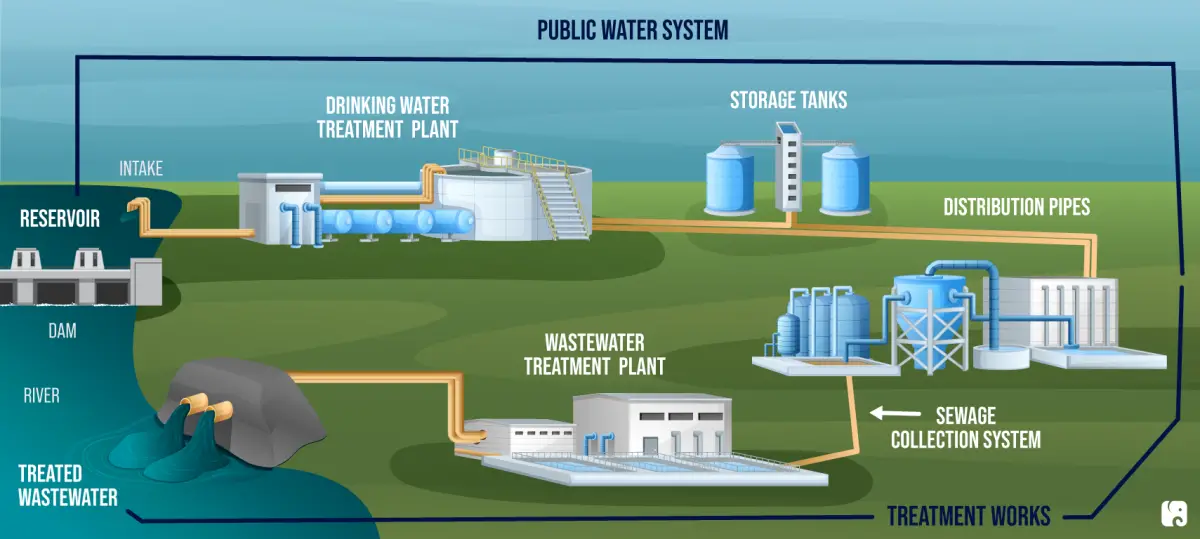Many cities have aging water infrastructures that hold, treat, and deliver water some as old as 100 years. Incredibly, some older community water systems contain bacteria, lead, and asbestos which became an environmental disaster in Flint, Michigan’s water infrastructure. What is Water Infrastructure?
Water infrastructure consists of what is built to pump, divert, transport, store, treat & deliver safe drinking H2O. In the U.S., This infrastructure consists of vast numbers of Groundwater wells, surface-water intakes, dams, reservoirs, storage tanks, drinking-water facilities, pipes, and aqueducts.
The Flint Michigan water crisis was a public health crisis that alarmed the world about our aging Water Infrastructure (April 2014–June 2016) involving the municipal water supply system of Flint, Michigan. Tens of thousands of Flint residents were exposed to dangerous levels of lead, and outbreaks of Legionnaire disease killed at least 12 people and sickened dozens more by using their old, deteriorated water infrastructure that was never replaced. This event helped bring Infrastructure to the forefront.
Introduction:
Have you ever wondered how drinking water travels to your home year after year with little interruption? The complex system that allows clean, usable water to flow from our taps is called water infrastructure. Grasping the essence of what exactly constitutes water infrastructure and its integral parts is profound. In this article, we unravel the intricacies of water infrastructure and divulge the key aspects and its future.
What is Water Infrastructure: The Key Aspects of Water Infrastructure
Water is essential. We rely on it from the moment we wake up in the morning and make a cup of coffee until we brush our teeth at night. While most water infrastructure is hidden from sight, it is foundational to our daily lives.
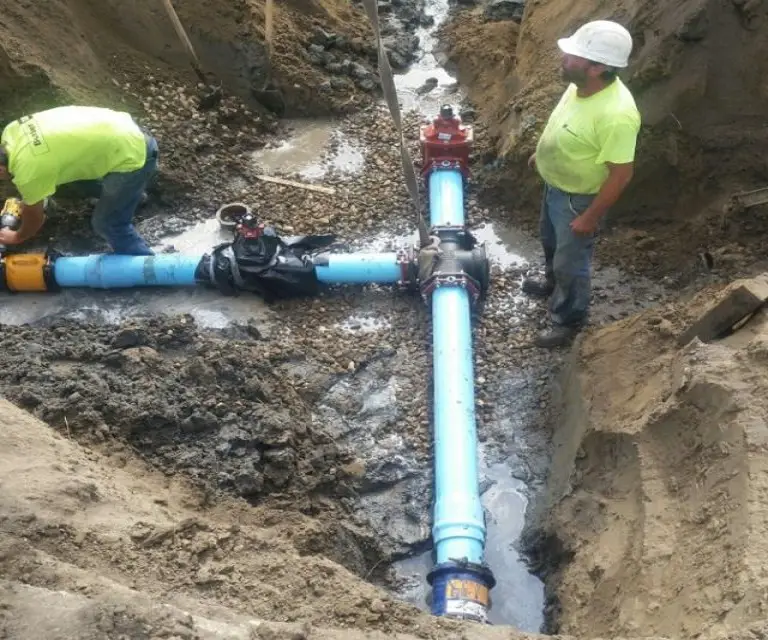
Our water infrastructure is aging and in need of repair to withstand the challenges of the 21st century. We must maintain water infrastructure to deliver clean drinking water and safely carry away and treat wastewater.
EPA helps renew water infrastructure across the country by identifying needs, funding infrastructure projects through multiple programs, and providing technical assistance to connect communities and tribes to federal funding.
There are few issues as important as Infrastructure, but in many areas of the country and worldwide, these types of improvements aren’t done until they break and stop working. Insufficient funding and planning just make the problems worse as they age. EPA has developed a plan to deal with aging water infrastructure, water pipes, water quality, the growing population, and problems associated with Global Warming and Climate change. The Aging Water Infrastructure (AWI) research program is part of EPA’s larger effort called the Sustainable Water Infrastructure (SI) initiative.
The SI initiative brings together water utilities and drinking water and wastewater utility managers, trade associations, local watershed protection organizations, and federal, state, and local officials to ensure that all components of our nation’s water infrastructure are included:
- drinking water treatment plants,
- drinking water distribution lines,
- Sewer lines
- Water storage facilities to meet future needs like reservoirs & aqueducts
- Dams & Levees
- Public Wells

The Environmental Protection Agency’s (EPA) 2000 Community Water System Survey (CWS) found that in “drinking water systems that serve more than 100,000 people, about 30 percent of the pipes are between 40 and 80 years old and about 10 percent of the pipes are more than 80 years old.”
The average service life of a water main or sewer line pipe is 50 years. In general, ductile iron has the longest service life while PVC has the shortest. This means that almost half the pipes in our water and sewer infrastructure need replacing now.
Coupled with the problems of Climate Change that bring more precipitation along with bigger storms and higher flooding and lack of precipitation or draught, Water Infrastructure can escalate to the top of the list in the near future.
Key Components of Water Infrastructure
Water infrastructure refers to the system of physical structures, facilities, and networks that are designed to collect, store, treat, distribute, and manage water resources. It encompasses a wide range of components and services related to water supply, sanitation, and water resource management. Water infrastructure is essential for ensuring access to clean and safe drinking water, as well as for managing wastewater and stormwater. Some key components of water infrastructure include:
- Water Sources: This includes rivers, lakes, reservoirs, groundwater, and other natural sources of water. Infrastructure may be built to capture and store water from these sources.
- Treatment Plants: Water treatment plants are facilities where raw water is treated to remove impurities, contaminants, and pathogens to make it safe for human consumption. Various processes like filtration, disinfection, and chemical treatment are used.
- Distribution Networks: These are the systems of pipes and pumps that transport treated water from treatment plants to homes, businesses, and industrial facilities.
- Wastewater Collection: This includes sewer systems that collect and transport wastewater from homes and businesses to wastewater treatment facilities.
- Wastewater Treatment Plants: These facilities treat wastewater to remove pollutants and contaminants before discharging the treated water back into the environment.
- Stormwater Management: Infrastructure for managing stormwater runoff, which may include drainage systems, retention ponds, and other structures to prevent flooding and protect water quality.
- Dams and Reservoirs: These are built to store water for various purposes, including drinking water supply, irrigation, and hydropower generation.
- Water Storage Tanks: These are used to store water for periods of high demand and as a reserve in case of emergencies.
- Pumping Stations: Facilities that pump water from lower elevations to higher elevations in areas where natural gravity flow is insufficient.
- Water Quality Monitoring: Systems and equipment to continuously monitor the quality of water at various points in the infrastructure to ensure it meets regulatory standards.
- Desalination Plants: In areas with limited freshwater resources, desalination plants are used to remove salt and other impurities from seawater or brackish water to make it suitable for drinking and other uses.

Water infrastructure is critical for public health, environmental protection, and economic development. It plays a fundamental role in providing access to safe and clean drinking water, protecting water resources, and managing wastewater to prevent pollution. Investments in water infrastructure are essential to ensure the sustainability and resilience of water
Water Utilities Infrastructure Funding
We all know what a broken water main looks like. It can stop traffic, cause fire hazards, and literally stop a city or community from functioning. This affects everyone, from residents to online businesses. With growing populations in most of the country in the last 80 years, the demand increases and increases every year.
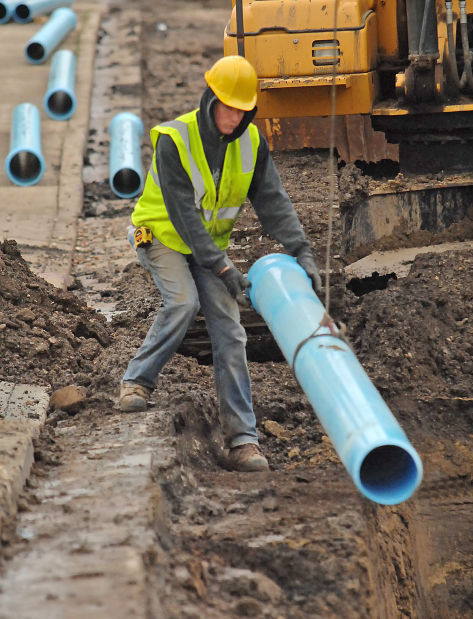
Think about it drinking water lines that were installed after the 2nd World War are delivering water to residents in cities around America.
The aging system is prone to problems such as increased breakage and lead and copper leaching due to the corrosion of existing pipes from hydrogen sulfide. These problems present concerns for public and environmental health and community water.
A break in the water main can lead to a decrease in water pressure, infiltrates, and exfiltrates, wasting water and allowing contaminants to enter the system underground and unnoticed.
Water main repairs are costly and can inconvenience the public as many pipes are under roads that must be dug up to repair the line. Aging wastewater pipes present an environmental hazard to drinking water by contaminating surface waters through breakages and overflows.
An older system, besides breaking, also has an increased amount of inflow and infiltration as joints and pipe material degrades. There is no way of fixing these pipes other than to dig them up and replace them.
Infrastructure projects like bridges and road work are in full view of the general public and are normally addressed at community meetings, but Water and Sewer infrastructure built underground normally fails first, then becomes an emergency situation, and needs money to keep the grid operating for the buildings on top.
Green Sustainable Water Infrastructure Program
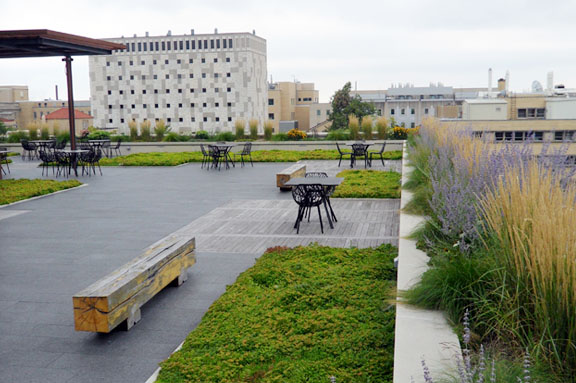
Few topics are as essential to our public well-being as water infrastructure. Our water state, the general measure of water quantity and quality in an area, is deeply connected to our lives.
This program is a leap forward in making our water systems more sustainable and resilient. It paves the way towards better access to clean and dependable water, offering a comprehensive framework to address the multiple dimensions of our water infrastructure, keeping the public’s convenience in mind, and thus giving everyone the equal right to claim access to this life-giving essence.
Green infrastructure uses innovative approaches to reduce stormwater and sewage overflows, protect water resources and drinking water, create green jobs, and reduce climate change impacts including flooding and saltwater intrusion.
Some Projects Include:
Rain and roof gardens, rainwater harvesting, and permeable pavements.
Planting trees, restoring wetlands, creating stream buffers, and functioning urban forests.
Water-efficient appliances and landscaping.
Wind and solar power.
Nutrient recycling in community gardens.
Onsite wastewater treatment and safe reuse.
The public needs to note the word ‘green’ in this context. Typically, the green link to infrastructure relates to energy conservation and sustainable management practices. The idea of this program is not only to rectify the existing water infrastructure but also to innovate, ensuring that new technologies and methods make our water systems more efficient and sustainable.
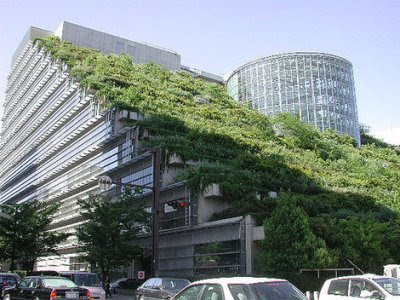
Public concerns about sustainability are addressed through this program. It is aimed at conserving our planet’s most precious resource — water. Sustainable water management implies responsible usage, with minimal waste, and recycling where possible. It also promotes the use of green technologies to treat and distribute water, thereby reducing the environmental footprint.
One of the immediate outcomes of the Green Sustainable Water Infrastructure Program has been improved public access to clean water, highlighting the significant access inequalities across different regions and communities. This program aims to bridge such gaps, ensuring that every citizen enjoys access to clean water.
The sustainable agenda of this program also fits well with the popular public sentiment about safeguarding our environmental future. Whether we talk about climate change challenges or the drive towards a green economy, sustainable water infrastructure becomes a core part of these discourses.
The Green Sustainable Water Infrastructure Program marks a significant shift in how we view our water infrastructure. It’s not merely about pipes, pumps, and treatment plants; it’s about a sustainable, green future, with better public access to safe water.
A shift in our water state that acknowledges not just present needs, but protects and considers future generations. It is about an inclusive water infrastructure system, where public access to clean, sustainable water isn’t just a luxury – it’s a right.
Conclusion:
In conclusion, water infrastructure plays a crucial role in our daily lives—from supplying clean drinking water to managing waste, mitigating flood risks, and supporting economic and agricultural activities. As we progress into the future, ensuring the sustainability, resilience, and efficiency of these systems becomes invaluable. Given the importance of water infrastructure, it’s essential for policymakers, engineers, and communities to recognize its many aspects, understand its challenges, and commit to improving it for the benefit of all. Remember, a solid water infrastructure protects public health, boosts economic growth, and safeguards our environment.

References:
EPA-WIFIA Projects
FAQ’s
Q: What is water infrastructure?
A: Water infrastructure refers to the systems, structures, and facilities that facilitate the collection, treatment, storage, and distribution of water. It’s not just limited to dams, treatment plants, and pipes, but also includes interconnected elements like plumbing systems, underground pipes, reservoirs, and catchments which transport water from the source to the tap.
Q: How crucial is water infrastructure in everyday life?
A: Water infrastructure is a fundamental element of our society. It ensures we have access to clean, safe drinking water, supports drainage systems to control flooding, supports agriculture and industry, and manages wastewater. Essentially, every time you use water—from filling a glass at the tap to flushing the toilet, you are using the water infrastructure.
Q: Why is the Sustainable Water Utilities Infrastructure Program important?
A: The Sustainable Water Utilities Infrastructure Program is an initiative to ensure continuous access to clean water of excellent quality. It enforces sustainability in managing water utilities. In addition, it is also about maintaining superior water quality through rigorous monitoring and stringent controls, upgrading obsolete water treatment plants, and implementing cutting-edge water filtration technologies.
Q: How does the ‘pay as you go’ framework in California affect water infrastructure?
A: California’s model of ‘pay as you go’ for funding infrastructure projects ensures a seamless rollout and maintenance, without passing the cost on to future generations. It implies proper project planning, prioritization, and funding allocations for various sectors of water infrastructure, ensuring reliable and efficient water utilities and infrastructure.
Q: What is the significance of the Green Sustainable Water Infrastructure Program?
A: The Green Sustainable Water Infrastructure Program is designed to make water systems more sustainable and resilient, promoting access to clean and dependable water for all. It encourages the use of green technologies in water treatment and distribution, thereby reducing the environmental impact. This program also addresses the inequalities in access to clean water across different regions and communities and is a vital part of the discourse on climate change and the drive toward a green economy.

